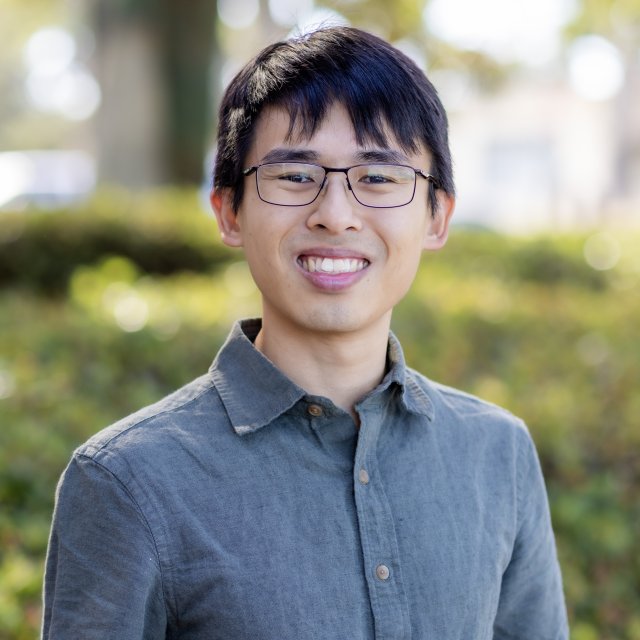Dr. Ho Fung (Edmund) Cheng is an organic chemist specializing in polymer and macromolecule synthesis. Born and raised in Hong Kong, Cheng graduated with an MChem at University of Oxford in 2016 and obtained his PhD in Chemistry at Northwestern University in 2022. During graduate school, he discovered his passion for mentoring students and his love for macromolecules. After a postdoc with Prof. Jeremiah Johnson at MIT, Cheng started as his independent career at Pepperdine University in 2024, before joining PLNU in 2025. At PLNU, Cheng leads an undergraduate-centric research lab that develops nucleic acid-inspired polymers. Outside of work, he loves spending time with his wife, Ashley, and their daughters, Anna and Isabella, and he is an amateur photographer.
Education
- Ph.D., Chemistry, Northwestern University
- MChem, Chemistry, University of Oxford
Courses Taught
- Intro to General, Organic, and Biological Chemistry – CHE 1003
- Organic Chemistry I Lab – CHE 2094L
- Research in Chemistry – CHE 4099
- Organic Chemistry I
- Organic Chemistry II
- Organic Chemistry II Lab
Experience in Field
- Pepperdine University, Assistant Professor of Organic Chemistry, 2024-2025
- Massachusetts Institute of Technology, Postdoctoral Associate, 2022–2024
Awards and Honors
- 2024 Infinite Expansion Award, MIT School of Science, 2024
- International Institute for Nanotechnology (IIN) Outstanding Researcher Award, 2021
- IPMI Outstanding Student Recognition, International Precious Metals Institute, 2021
- Ryan Fellowship, Northwestern University, 2019–2021
- First Class Honors in Chemistry, University of Oxford, 2016
- Scholar, Christ Church College, University of Oxford, 2013–2016
Dissertations, Presentations, and Publications
- Li, Y.; Zhou, W.; Zhou, Y.; Cheng, H. F.; Lee, B.; Hu, X.; Roth, E. W.; Dravid, V. P.; Glotzer, S. C.; Mirkin, C. A. “Cocrystals combining order and correlated disorder via colloidal crystal engineering with DNA”, Sci. Adv. 2025,11, eadu4919.
- Prince, E.‡; Cheng, H. F.‡; Banal, J. L.; Johnson, J. A. “Reversible nucleic acid storage in deconstructable glassy polymer networks”, J. Am. Chem. Soc. 2024,146, 7066–17074.
- Cheng, H. F.; Johnson, J. A. “Controlling the orientation of hole transport molecules in bottlebrush polymers for enhanced OLED performance (Research Highlight)”, Aggregate 2022, 00, e259.
- Wang, S. ‡ ; Lee, S. ‡ ; Du, J. S. ‡; Partridge, B. E.; Cheng, H. F.; Zhou, W.; Dravid, V. P.; Lee, B.; Glotzer, S. C.; Mirkin C. A. “The emergence of valency in colloidal crystals through electron equivalents”, Nat. Mat. 2022, 21, 580–587.
- Mirkin, C. A.; Distler, M. E.; Cheng, H. F.; Gibson, K. J. “Oligonucleotide Dendrimers for Dynamic and Functional Colloidal Crystal Engineering”, US 20250043081 A1.
- Cheng, H. F.‡; Distler, M. E.‡; Lee, B.; Zhou, W.; Weigand, S.; Mirkin C. A. “Nanoparticle Superlattices Through Template-Encoded DNA Dendrimers”, J. Am. Chem. Soc. 2021,143, 17170–17179.
- Gu, Y.; Distler, M. E.; Cheng, H. F.; Huang, C.; Mirkin C. A. “A General DNA-Gated Hydrogel Strategy for Selective Transport of Chemical and Biological Cargos”, J. Am. Chem. Soc. 2021,143, 17200–17208.
- Ebrahimi, S. B.;‡Samanta, D.‡; Partridge, B. E.; Kusmierz, C. D.; Cheng, H. F.; Grigorescu, A. A.; Chávez, J. L.; Mirau, P. A.; Mirkin, C. A. “Programming Fluorogenic DNA Probes for Rapid Detection of Steroids”, Angew. Chemie., Int. Ed.2021, 60, 15260–15265.
- Cheng, H. F.‡; Paul, M.‡; d’Aquino, A. I.; Stern, C. L.; Mirkin C. A. “Multi-State Dynamic Coordination Complexes Interconverted through Counterion-Controlled Phase Transfer”, Inorg. Chem. 2021, 60, 4755–4763.
- Cheng, H. F.‡; Wang, S.‡; Mirkin C. A. “Electron-Equivalent Valency through Molecularly Well-Defined Multivalent DNA”, J. Am. Chem. Soc. 2021, 143, 1752–1757.
- Samanta, D.‡; Ebrahimi, S. B.‡; Kusmierz, C. D.; Cheng, H. F.; Mirkin, C. A. “Protein Spherical Nucleic Acids for Live-Cell Chemical Analysis”, J. Am. Chem. Soc. 2020, 142, 13350–13355.
- Mirkin, C. A.; Ebrahimi, S. B.; Samanta, D.; Cheng, H. F. “Forced intercalation (fit)-aptamers: probes based on forced intercalation”, US 20220348985 A1.
- Ebrahimi, S. B.‡; Samanta, D.‡; Cheng, H. F.; Nathan, L. I.; Mirkin, C. A. “Forced Intercalation (FIT)-Aptamers”, J. Am. Chem. Soc.2019, 141, 13744–13748.
- Cheng, H. F.; d’Aquino, A. I.; Barroso-Flores, J.; Mirkin, C. A. “A Redox-Switchable, Allosteric Coordination Complex”, J. Am. Chem. Soc.2018, 140, 14590–14594.
- d’Aquino, A. I.; Cheng, H. F.; Barroso-Flores, J.; Kean, Z. S.; Mendez-Arroyo, J.; McGuirk, C. M.; Mirkin, C. A. “An Allosterically-Regulated, Four-State Macrocycle”, Inorg. Chem.2017, 57, 3568–3578.
- Xu, Q.; Cheng, H.; Lehr, J.; Patil, A. V.; Davis, J. J. “Graphene Oxide Interfaces in Serum Based Autoantibody Quantification”, Anal. Chem.2015, 87, 346–350.
